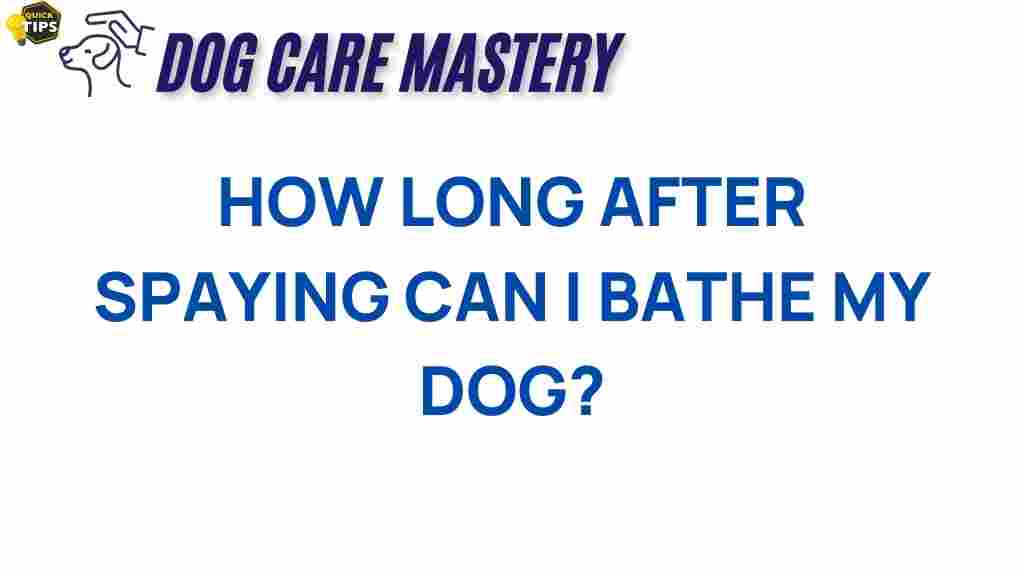The Essential Guide: When Can You Bathe Your Dog After Spaying?
Spaying is a common surgical procedure for female dogs, involving the removal of the ovaries and usually the uterus. This operation not only helps control the pet population but also contributes to the overall health of your furry friend. After the spaying procedure, pet owners have numerous questions, particularly regarding post-operative care. One common concern is, “When can I bathe my dog after spaying?” In this essential guide, we’ll explore everything you need to know about bathing your dog after spaying, ensuring a smooth recovery for your beloved companion.
Understanding Spaying
Before delving into post-operative care, it’s crucial to understand what spaying entails. Spaying is a surgical procedure performed by a veterinarian, usually under general anesthesia. While the operation itself is generally safe, the recovery process can require careful attention from pet owners. Knowing when and how to care for your dog after spaying is vital for a successful recovery.
Why Bathing Can Wait
After spaying, your dog will have an incision site that needs proper care. Bathing your dog too soon can pose several risks:
- Infection: Water can introduce bacteria to the incision, leading to potential infections.
- Wound Healing: Soaking the incision can disrupt the healing process, causing the stitches to loosen.
- Discomfort: Bathing may cause discomfort to your dog, especially if the incision is still sensitive.
When Can You Bathe Your Dog After Spaying?
Generally, it’s advisable to wait at least 10 to 14 days after spaying before bathing your dog. However, the exact timeframe can depend on several factors:
- Veterinarian’s Advice: Always follow your vet’s recommendations regarding post-operative care.
- Type of Surgery: If your dog underwent additional procedures, the recovery time might be longer.
- Incision Healing: Monitor the incision site for signs of healing or complications.
Signs Your Dog is Ready for a Bath
Before bathing, ensure that your dog’s incision site is properly healed. Look for the following signs:
- No visible redness or swelling around the incision.
- No discharge or oozing from the incision site.
- Your dog is not excessively licking or biting at the incision.
- Vet has cleared your dog for bathing during a follow-up appointment.
Step-by-Step Process: Preparing for a Bath
Once your dog is ready for a bath, follow these steps to ensure a safe and comfortable experience:
- Gather Supplies: Prepare the following items:
- Dog shampoo (preferably hypoallergenic)
- Towels
- Non-slip mat for the bath or shower
- Brush
- Choose the Right Location: Select a calm and safe environment. A bathtub or a big sink can work well.
- Check the Water Temperature: Ensure the water is lukewarm, as hot or cold water can be uncomfortable.
- Brush Your Dog: Before getting them wet, brush your dog’s coat to remove any tangles or debris.
- Introduce Your Dog to the Water: Allow your dog to acclimate to the bathing area before getting wet.
- Wet the Coat Carefully: Use a cup or a gentle showerhead to wet your dog’s coat, avoiding the incision area.
- Apply Shampoo: Use a small amount of dog shampoo, lathering it gently into the coat without touching the incision.
- Rinse Thoroughly: Make sure to rinse out all shampoo to avoid skin irritation.
- Dry Gently: Use towels to dry your dog off, avoiding any vigorous rubbing around the incision area.
- Monitor for Reactions: Keep an eye on your dog post-bath for any signs of discomfort or irritation.
Post-Bathing Care
After bathing, there are some additional care steps to follow:
- Keep the Incision Dry: Ensure the incision area remains dry and clean.
- Avoid Activities: Prevent your dog from running or jumping for several days post-bath.
- Check for Issues: Regularly inspect the incision for any signs of infection or complications.
Troubleshooting Common Issues
Despite your best efforts, issues may arise during the post-spaying recovery process. Here are some common problems and solutions:
- Excessive Licking: If your dog is licking the incision, consider using an Elizabethan collar (cone) to prevent access.
- Signs of Infection: If you notice redness, swelling, or discharge, contact your veterinarian immediately.
- Behavioral Changes: If your dog seems unusually lethargic or in pain, consult your vet for advice.
Conclusion
Bathing your dog after spaying is an important component of post-operative care, but timing and method are crucial for ensuring a smooth recovery. By waiting at least 10 to 14 days after the surgery, monitoring the incision, and following the steps outlined in this guide, you can help your pet remain healthy and comfortable after their spaying procedure. Always consult with your veterinarian for personalized advice tailored to your dog’s specific needs.
For more tips on dog care and health, check out our article on dog grooming tips. If you have any concerns about your dog’s recovery, don’t hesitate to reach out to your veterinarian or visit a reliable source like the American Kennel Club.
This article is in the category Health and created by dogcaremastery Team
